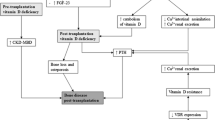Abstract
KH1060 is a new 20-epi-vitamin D3 analog, which has exerted a considerable immunosuppressive potency in vitro. We have tested in vivo the effect of KH1060 on the suppression of renal allograft rejection in the rat. Allogenic kidney transplantation from DA donor rats to Lewis recipient rats treated intraperitoneally with KH1060 in doses from 0.2 to 6 μg/kg/day, or saline (placebo group), or CyA 10 mg/kg/day for 10 days (positive control group), was performed. Median graft survival time in KH1060-treated groups was 7–9 days, in the placebo group 6 days, whereas CyA led to long-term graft survival, 34 days in 50% of rats and >100 days in 50% of rats. In vivo, KH1060 failed to prolong renal allograft survival considerably, and led to development of hypercalcemia. Our results stress the existence of a large discrepancy between the in vitro and in vivo immunoregulatory effects of this vitamin D analog.
Similar content being viewed by others
References
Provvedini DM, Tsukas CD, Deftos LJ, Manolagas SC (1983) 1,25-Dihydroxyvitamin D3 receptors in human leucocytes. Science 221:1181–1182
Tsukas CD, Provvedini DM, Manolagas SC 1,25-Dihydroxy-vitamin D3 (1984). A novel immunoregulatory hormone. Science 224:1438–1439
Tsukas CD, Watry D, Escobar SS, Provvedini DM, Dinarello CA, Hustmyer FG, Manolagas SC (1989) Inhibition of interleukin-1 production by 1,25-dihydroxyvitamin D3. J Clin Endocrinol Metab 69:127–133
Rigby WFC, Denome S, Fanger MW (1987) Regulation of lymphokine production and human T lymphocyte activation by 1,25-dihydroxyvitamin D3. J Clin Invest 79:1659–1664
Muller K, Diamant M, Bendtzen K (1991) Inhibition of production of interleukin-6 by 1,25-dihydroxyvitamin D3. Immunol Lett 28:115–120
Brown AJ, Finch JL, Lopez-Hilker S, Dusso A, Ritter C, Pernalete N, Slatoposky E (1990) New active analogues of vitamin D with low calcemic activity. Kidney Int 38:S22-S27
Abe J, Takita Y, Nakano T, Miyaura C, Suda T, Nishii Y (1989) A synthetic analogue of vitamin D3, 22-oxa-1,25-dihydroxyvitamin D3, is a potent modulator of in vivo immunoregulating activity withooutinducing hypercalcemia in mice. Endocrinology 124:2645–2647
Binderup L, Latini S, Binderup E, Bretting C, Calverley M, Hansen K (1991) 20-epi-vitamin D3 analogues: a novel class of potent regulators of cell growth and immune responses. Biochem Pharmacol 42:1569–1575
Lillevang ST, Rosenkvist J, Andersen CB, Larsen S, Kemp E, Kristensen T (1992) Single and combined effects of the vitamin D analogue KH1060 and cyclosporin A on mercuric-chloride-induced autoimmune disease in BN rat. Clin Exp Immunol 88: 301–306
Veyron P, Pamphile R, Binderup L, Touraine JL (1993) Two novel vitamin D analogues, KH1060 and CB 966, prolong skin allograft survival in mice. Transplant Immunol 1:72–76
Lewin E, Colstrup H, Pless V, Ladefoged J, Olgaard K (1993) A model of reversible uremia employing isogenic kidney transplantation in the rat. Scand J Urol Nephrol 27:115–120
Funder JW, Pearce PT, Smith R, Smith AI (1988) Mineralocorticoid action: target tissue specificity is enzyme, not receptor, mediated. Science 242:583–585
Dusso A, Negrea L, Lopez-Hilker S, Finch J, Mori T, Nishii Y, Slatopolsky E, Brown AJ (1991) Noncalcemic vitamin D analogs and mechanisms for their selectivity. 8. Workshop on vitamin D (abstracts) Paris, p 195
Tsugawa N, Okano T, Masuda S, Takeuchi A, Kobayashi T, Nishii Y (1989) Comparative study on the protein binding of a novel synthetic vitamin D3 analogue [22-oxa-1,25-dihydroxy-vitamin D3] and various vitamin D3 metabolites (abstract 418) J Bone Miner Res 4:S222
Slatopolsky E, Berkoben M, Kelber J, Brown A, Delmez J (1992) Effects of calcitriol and non-calcemic vitamin D analogs on secondary hyperparathyroidism. Kidney Int 42:S43-S49
Klinger M, Alexiewicz JM, Linker-Israeli M, Pitts TO, Gaciong Z, Fadda GZ, Massry SG (1990) Effect of parathyroid hormone on human T cell activation. Kidney Int 37:1543–1551
Lewin E, Ladefoged J, Brandi L, Olgaard K (1993) Parathyroid hormone-dependent T cell proliferation in uremic rats. Kidney Int 44:379–384
Perris AD, Weiss LA, Whitfield JF (1970) Parathyroidectomy and the induction of thymic atrophy in normal, adrenalectomized and orchidectomized rats. J Cell Physiol 76:141–150
Perris AD, Edwards DJ, Atkinson MJ (1984) Some effects of parathyroidectomy on cell-mediated immune responses in the rat. J Endocrinol 102:257–263
Rigby WFC, Hamilton BJN (1991) Regulation of T lymphocyte activation at a posttranscriptional level by 1,25-dihydroxyvitamin D3. 8. Workshop on vitamin D (abstract) Paris, p 196
Author information
Authors and Affiliations
Rights and permissions
About this article
Cite this article
Lewin, E., Olgaard, K. The in vivo effect of a new, in vitro, extremely potent vitamin D3 analog KH1060 on the suppression of renal allograft rejection in the rat. Calcif Tissue Int 54, 150–154 (1994). https://doi.org/10.1007/BF00296066
Received:
Accepted:
Issue Date:
DOI: https://doi.org/10.1007/BF00296066




